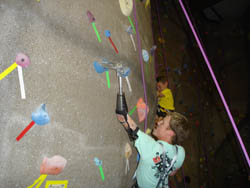Designers: Clark Daniel, Ben Haynes, Archana Ramireddy, and Karli Spetzler
Supervising Professor: Kevin Caves and Richard Goldberg
 INTRODUCTION
INTRODUCTION
Our client is an adult with a below elbow amputation on his left side, who wants to regain his ability to rock climb. He has full shoulder motion, but only flexion/extension at his left elbow. He also lacks the ability to pronate and supinate his prosthetic forearm. The goal of this project was to design an attachment to his carbon fiber socket that will increase his ability to rock climb both indoor and outdoor surfaces. The Prosthetic Climbing Aid implements a set of modified ice axe blades that are set in a rotating aluminum block. The block has 60? degrees of motion and simulates the inversion/eversion motion of the wrist to give him as much range of motion as possible. The device rotates freely when unloaded, but it locks into one of 5 set positions when weight is placed on the arm to prevent it from slipping from the desired grip.
 SUMMARY OF IMPACT
SUMMARY OF IMPACT
The client commented, “The device the students built allows for a couple things. Because of the lateral movement available in the wrist I have a wider variety of holds I can get to, as well as being able to attain some angles of attack that were previously unavailable. And the increased surface area of the “fingers” allows me a more stable position to work from. All in all, it provides for a better degree of mechanical advantage which in turns makes climbing a little more solid and stable for me.”
TECHNICAL DESCRIPTION
Climbing Prosthesis
A ¾” diameter aluminum rod was used to attach to the climbing prosthesis to client’s existing carbon fiber socket. The rod fits into the rotation mechanism which is made from two pieces of 6061 Aluminum Alloy and holds three custom fabricated ice axe blades made from Type 303 stainless steel (Figure 1).
An hourglass-shaped hole has been machined to allow the rod to fit inside the rotation mechanism. A barrel bolt provides a pivot point for the rotation of the device. Figure 2 shows the inner face of the rotation mechanism where there are a series of 3/16” grooves that accept a 1/8” coiled spring pin attached to the aluminum rod. The pin slides into one of the slots when the arm is pulled on a rock surface. This locks the rotation mechanism when loaded. When the device is unloaded, the rotation mechanism is free to rotate, but when loaded, the device slides up the rod and the coiled pin rests into one of five grooves, locking it in the specific angle. The weight-bearing element is the coiled spring pin that is rated for 2,000 lbs of double shear stress. The length of the rod puts the ice axe blades in the same plane as the fingers of his right hand, allowing him a more stable, natural climbing experience.
Device Harness
 The device harness is used to reduce the amount of stress placed on the elbow strap of the prosthesis. It is not intended as a weight-bearing device. A bungee cord is used to transfer weight from the prosthesis to the harness. A tricep cuff that attaches to the prosthesis was provided by our client. A ¼”-diameter bungee cord attaches the harness to this cuff and is always in tension. The cuff remains snuggly on our client’s upper arm using a 1” elastic band with a Velcro attachment. The material for the major straps is 1” nylon webbing rated at 14 kN tensile strength. To keep the harness from sliding up his body and getting out of position, this harness is connected to the client’s actual climbing harness with two cinch lock buckles in the back and two side release buckles in the front. The side release buckles were used to allow for frequent adjustment that can be manipulated with one hand.
The device harness is used to reduce the amount of stress placed on the elbow strap of the prosthesis. It is not intended as a weight-bearing device. A bungee cord is used to transfer weight from the prosthesis to the harness. A tricep cuff that attaches to the prosthesis was provided by our client. A ¼”-diameter bungee cord attaches the harness to this cuff and is always in tension. The cuff remains snuggly on our client’s upper arm using a 1” elastic band with a Velcro attachment. The material for the major straps is 1” nylon webbing rated at 14 kN tensile strength. To keep the harness from sliding up his body and getting out of position, this harness is connected to the client’s actual climbing harness with two cinch lock buckles in the back and two side release buckles in the front. The side release buckles were used to allow for frequent adjustment that can be manipulated with one hand.
Figure 3 shows the client climbing with the device. Cost of parts for the device was approximately $170.